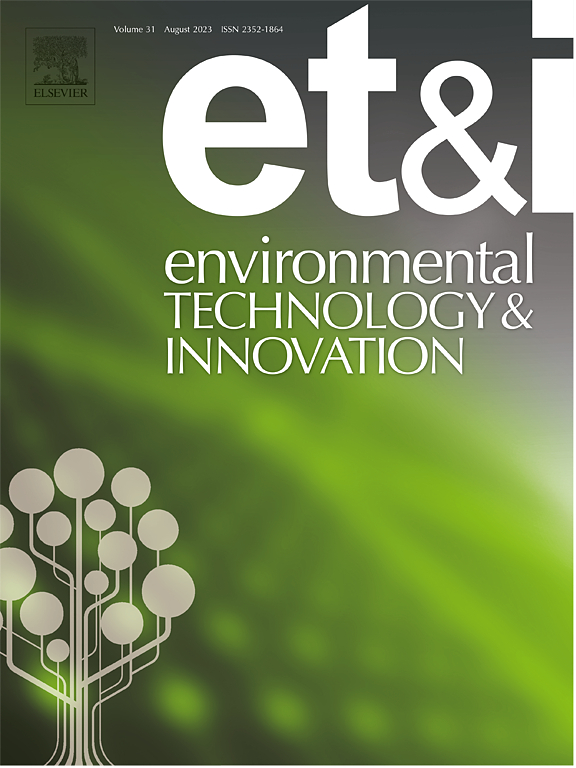Biochar-based controlled-release ammonium phosphate fertilizer: Synthesis and impact on soil nutrient dynamics, wheat growth, and yield under controlled conditions
IF 6.7
2区 环境科学与生态学
Q1 BIOTECHNOLOGY & APPLIED MICROBIOLOGY
引用次数: 0
Abstract
Current agricultural practices prioritize increasing crop yields through extensive fertilizer use. However, overreliance on nitrogen (N) and phosphorus (P) fertilizers has led to environmental degradation, including eutrophication and inefficient nutrient use, raising sustainability concerns. This study aims to develop a biochar-supported controlled-release fertilizer (BAPF) containing N and P, and evaluate its impact on soil nutrient dynamics, nutrient recovery, plant growth, and yield. BAPF was synthesized by impregnating biochar derived from oat hulls with urea and diammonium phosphate. An eight-week soil incubation experiment compared nutrient release dynamics between BAPF, conventional fertilizers (CF), oat hull biochar (OHB), and a control (CT). BAPF demonstrated consistent nutrient release, maintaining higher N and P availability over time than CF. By day 60, total N concentration in the BAPF treatment was 6 % higher than CF, while P availability was consistently 20 % higher. BAPF also exhibited lower ammonification rates compared to unfertilized treatments, while nitrification rates were 2.6 times greater compared to OHB and CT, demonstrating enhanced nitrogen conversion efficiency. In a greenhouse trial using spring wheat as a model plant, BAPF improved growth, nutrient uptake, and grain yield compared to CF, OHB, and CT. Total biomass and grain yield increased by approximately 15 % relative to CF, and nutrient recovery rates were significantly higher, with N apparent recovery (ARN) of 55.0 % compared to 36.5 % for CF. Additionally, the apparent P recovery rose from 8.9 % in CF to 18.5 % in BAPF. The findings suggest that BAPF improves nutrient use efficiency and enhances grain productivity compared to conventional methods. Its controlled-release properties lead to longer nutrient availability, better nutrient recovery, and increased crop productivity, even in high P-fixing soils. Therefore, BAPF offers an effective alternative to reduce reliance on synthetic fertilizers, enhancing sustainability in agricultural systems.
生物炭基控释磷铵肥料的合成及其对土壤养分动态、小麦生长和产量的影响
目前的农业实践优先考虑通过大量使用化肥来提高作物产量。然而,过度依赖氮(N)和磷(P)肥料导致了环境退化,包括富营养化和养分利用效率低下,引起了可持续性问题。本研究旨在开发一种含氮磷生物炭控释肥料(BAPF),并评价其对土壤养分动态、养分恢复、植物生长和产量的影响。以燕麦壳为原料,用尿素和磷酸二铵浸渍生物炭合成了BAPF。通过为期8周的土壤培养试验,比较了BAPF、常规肥料(CF)、燕麦壳生物炭(OHB)和对照(CT)的养分释放动态。BAPF表现出一致的养分释放,随着时间的推移保持比CF更高的N和P有效性。到第60天,BAPF处理的总氮浓度比CF高6 %,而P有效性始终高20 %。与未施肥处理相比,BAPF的氨化率也较低,而硝化率是OHB和CT的2.6倍,表明氮转化效率提高。在以春小麦为模式植物的温室试验中,与CF、OHB和CT相比,BAPF改善了生长、养分吸收和籽粒产量。总生物量和籽粒产量比CF提高了约15 %,养分回收率显著提高,氮表观回收率(ARN)为55.0% %,而CF为36.5% %。此外,P表观回收率从CF的8.9 %提高到BAPF的18.5 %。结果表明,与常规方法相比,BAPF提高了养分利用效率,提高了粮食产量。它的控释特性导致更长的养分有效性,更好的养分恢复,并提高作物生产力,即使在高固磷土壤。因此,BAPF提供了一种有效的替代方案,以减少对合成肥料的依赖,提高农业系统的可持续性。
本文章由计算机程序翻译,如有差异,请以英文原文为准。
求助全文
约1分钟内获得全文
求助全文
来源期刊

Environmental Technology & Innovation
Environmental Science-General Environmental Science
CiteScore
14.00
自引率
4.20%
发文量
435
审稿时长
74 days
期刊介绍:
Environmental Technology & Innovation adopts a challenge-oriented approach to solutions by integrating natural sciences to promote a sustainable future. The journal aims to foster the creation and development of innovative products, technologies, and ideas that enhance the environment, with impacts across soil, air, water, and food in rural and urban areas.
As a platform for disseminating scientific evidence for environmental protection and sustainable development, the journal emphasizes fundamental science, methodologies, tools, techniques, and policy considerations. It emphasizes the importance of science and technology in environmental benefits, including smarter, cleaner technologies for environmental protection, more efficient resource processing methods, and the evidence supporting their effectiveness.
 求助内容:
求助内容: 应助结果提醒方式:
应助结果提醒方式:


